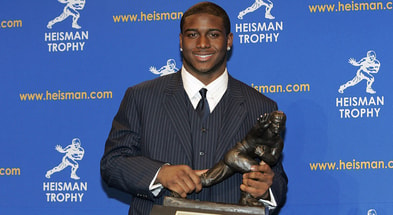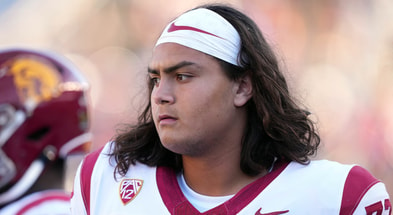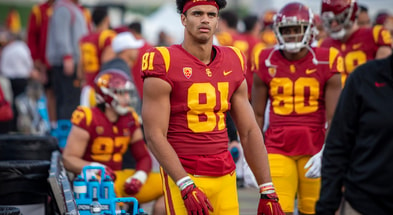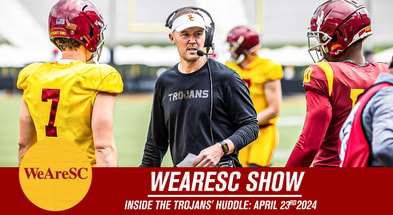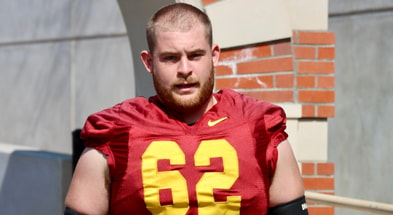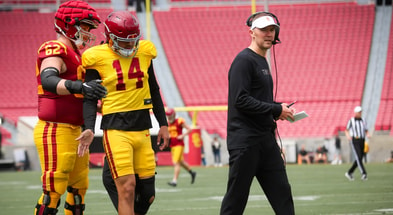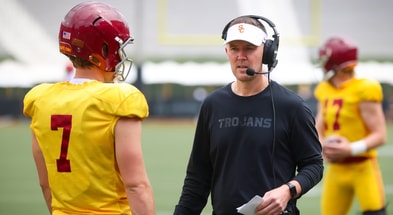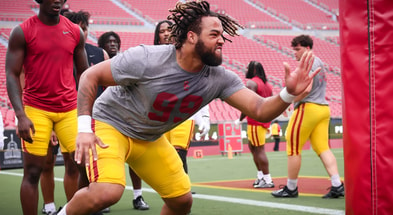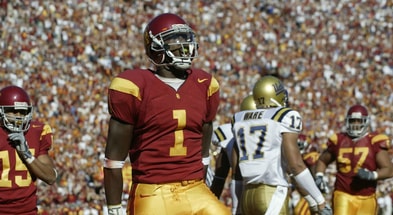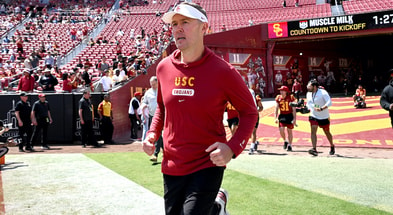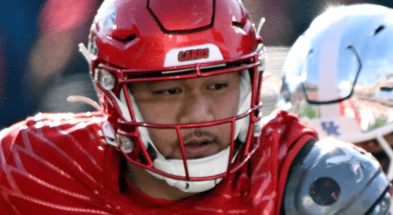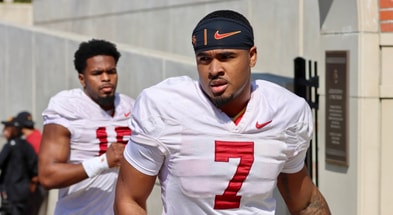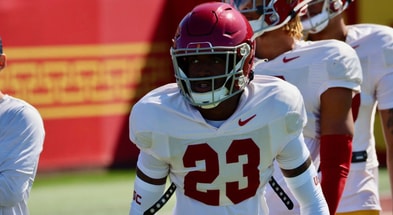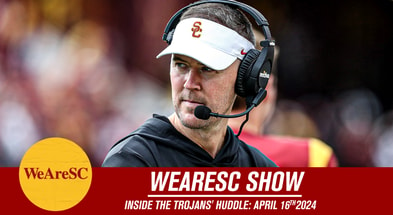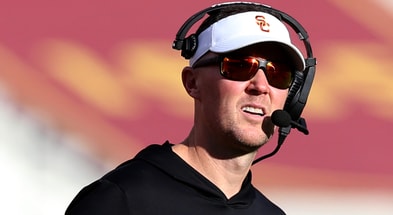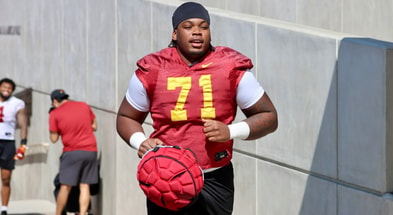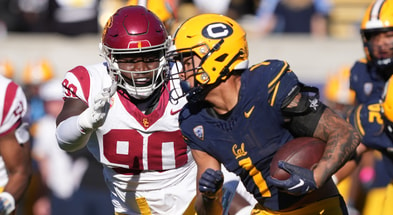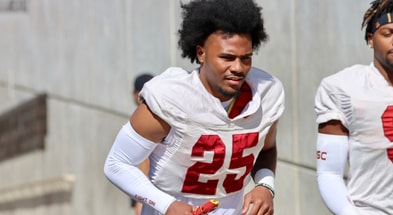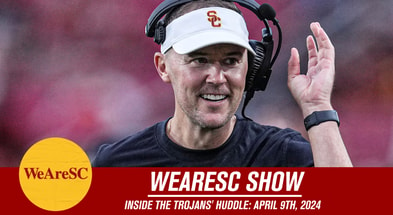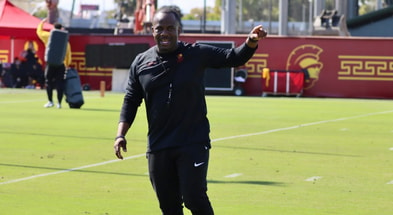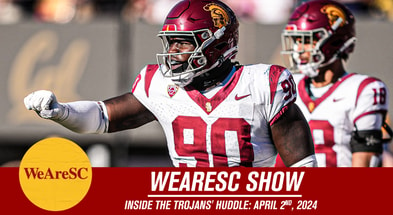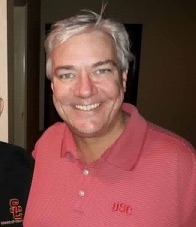Musings From Arledge: How Good is USC?
I’m going to save my rant for this week’s Inside the Trojans Huddle. Let’s talk here about what really matters: how good is this USC team?
My bottom line: this is a legitimate top-10 team with a shot at the college football playoff, despite the obvious struggles on defense.
People like to say that defense wins championships. That’s not really true. As defensive guru Nick Saban was forced to admit, good defense does not beat good offense anymore. Defense matters, obviously. But the key to winning championships is an explosive, high-scoring offense. You cannot win without one in modern college football.
And USC is elite offensively. The second half against Stanford was disappointing, especially after how dominant the offense was in the first half. But two things are worth keeping in mind. First, it’s hard to stay sharp when you have a 24-point lead and it feels like the game is in the bag. You don’t want a team to take its foot off the gas, but it’s common. It happens to everybody.
Second, some of those second-half drives were the result of unusual circumstances. You had some drives end when receivers fell down on bad turf. You had a drive end on an offensive pass interference penalty. And you had a drive where Caleb Williams uncharacteristically missed badly on consecutive deep throws to open receivers, both of which probably would have been touchdowns.
I’m not worried about this offense. This could be the best offense in the country. That’s a pretty good start.
Defensively, it’s a mixed bag, obviously. USC is making a lot of big plays. Four turnovers in each game is incredible. But it’s not just the turnovers. The Trojans had five sacks and 12 tackles for loss against Stanford. Those are great numbers. Anytime a defense forces four turnovers, gets five sacks, and gets 12 tackles for loss, they have a really good chance of winning, especially with an offense like this one.
At the same time, it feels like the defense is getting gashed all the time, particularly on the ground. That’s not entirely true, in reality. Stanford’s two running backs had 88 yards on 19 carries and 77 yards on 16 carries — both under five yards per carry. It’s true enough that it’s frustrating and concerning.
The pass defense was better statistically. Tanner McKee was 20 of 35 passing for 220 yards (only 6.3 per attempt) with one TD and two picks. Those are pretty average numbers, and his QBR of 53.9 reflects that. (To put that in perspective, a QBR of 53.9 would put you 78th in the country this year.). But the pass interference calls extended a lot of drives and added a lot to that yardage total.
A point on that. A lot of those calls were garbage. I know Pac-12 refs can’t let guys play. They just don’t know how. But a lot of those calls were too ticky tack. Pulling on a guy when you don’t have to is a problem. But pass interference calls are going to happen when a defense is playing properly. We want the secondary to be physical and aggressive. The alternative is to let offensive guys make plays.
The defense is definitely giving up yards. They’re giving up far too many long drives. It’s not a dominant unit. But it’s doing some things right. They tackle pretty well. They’re very athletic in the back seven, and they make some big plays. And most of the turnovers this week were caused by great defensive plays. Blackmon’s pick in the end zone was a perfect play. Max Williams’ first pick was caused in part by Eric Gentry’s 6-foot-6 frame forcing the QB to throw it high. And the fumble near the goal line was a perfect hit by Max Williams with his helmet right on the ball.
I suspect this group will continue to be opportunistic. They will not dominate anybody. But they’ll make some big plays that get the ball back to the offense.
The fundamental problem is that the defensive line is not a major threat. Try this thought experiment: can you imagine an opponent playing that slow mesh strategy against a defensive line with Mike Patterson or Sed Ellis? Me either. Mike and Sed would have eaten the QB and RB as they stood there in the pocket.
This line does not have the athletes to consistently beat blockers and cause chaos in the backfield, largely because USC does not have the talent on the defensive front that it has on most of the rest of the roster. Tuli is a stud. Figueroa is playing well. Solomon Byrd flashed yesterday. Solo looks like he might have something to add. But I don’t know what we have in Romello Height, who can’t stay healthy, and I think we simply need to admit that Korey Foreman isn’t the player everybody hoped he would be. He’s just a guy. In baseball terms, his WAR would be right at zero. It is what it is. I hope he proves me wrong. But in a game where Stanford played 80 plays and Foreman had to play the bulk of the game, two solo tackles, no sacks, and no tackles for loss isn’t getting it done. USC didn’t need to recruit a five-star to get that production; they could recruit just about any three-star edge rusher in Southern California and get that.
So why do I say this is absolutely a top-ten team with a shot at the playoff?
Because probably the two most important stats in football are turnover margin and yards per play differential. USC has been good at both and will likely continue to be.
Being 1 to 1.5 yards per play better than your opponent in yards per play equals an 86% chance of winning and an average scoring margin of +13.2. A differential of 2-3 yards per play equals a 95% of winning. The last five national champions had the following yards-per-play differentials: Georgia (+2.8), Bama (+2.8), LSU (+2.6), Clemson (+3.1) and Bama (+2.5).
Against Stanford, USC was (according to my unofficial calculation) at 8.0 offensively and 5.5 defensively for a difference of 2.5. You will almost never lose a game with that level of differential. For the season, USC is at 8.3 on offense and 4.8 on defense, for a difference of 3.5. That number will probably go down some as the Rice figures were off-the-charts. But USC’s offense is too talented and too well-coached for opposing teams to match USC’s numbers. They will overwhelm almost everybody on the schedule, so even if USC is fairly average in yards per play defensively, their offensive numbers will likely keep them in national-title contender range.
Turnover margin is obviously also critical. For every .5 increase in turnover margin, a team can expect to win an additional 1.25 extra games. Or, put another way, a turnover margin of plus one equals a 65% chance of winning. Plus two and you’re at 76%. Plus three and you’re at 88%. Plus four and you almost never lose.
Some people argue that turnovers equal out over time. I don’t think that’s true. Fumbles tend to even out over time. But interceptions do not. Great quarterbacks can avoid turnovers consistently. Tom Brady and Aaron Rodgers don’t have years where they are below average in interceptions. In his career, Caleb Williams has four interceptions in 260 attempts — and those are his numbers when he has been at his least experienced. The kid is good. USC also has an athletic, aggressive back seven. They will pick off their opponents far more than USC’s opponents will intercept Caleb Williams. Pete Carroll’s teams consistently had very favorable turnover margins. This USC team is likely to do the same.
But that’s on the whole. It doesn’t mean USC won’t have a game or two where the numbers go the other way, and that’s where the season is decided.
The bottom line is that USC will overwhelm most of their opponents. Utah can keep up. UCLA’s offense is good enough to keep up. There will be another game or two — Oregon State on the road, maybe? — where the Trojans will be in a dog fight well into the fourth quarter. Win all but one of those, and they have a legitimate shot at the playoff. Lose two of them, and you can forget it.
